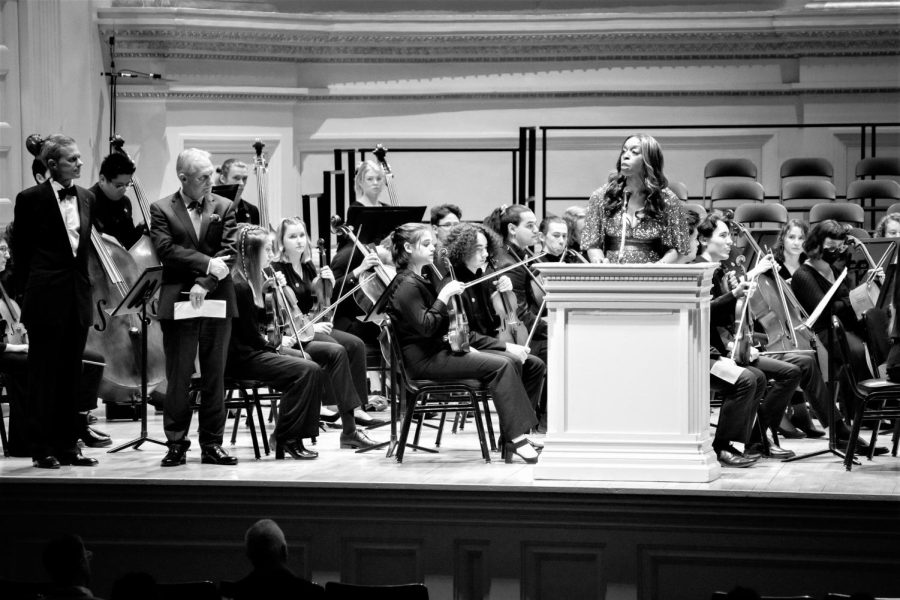UNITAR Partnership Brings Opportunity to Oberlin
President Ambar Speaks at Carnegie Hall alongside U.N. General Assembly President Csaba Körösi and GFPA President Benjamin Woodroffe.
On Friday, Dec. 2, the Oberlin Orchestra and Choir performed at Carnegie Hall before the United Nations General Assembly, kicking off the College’s partnership with the United Nations Institute for Training and Research and the Global Foundation for the Performing Arts. This cohort of students represented Oberlin hundreds of miles from the community itself, and in doing so captured the imagination and respect of the U.N. Through one evening of music, Oberlin students reached the entire world.
By all accounts, the future of the partnership is even more exciting than the inaugural concert. Members of Oberlin’s administration responsible for mapping the next steps of the partnership spoke to the Review about possible internship and Winter Term programs, post-graduate pairings with UNITAR’s international network of institutions, and several other opportunities. Next year the College is launching an English for Speakers of Other Languages summer intensive program that will bring incoming international students to campus for eight weeks of hands-on learning. The extended amount of time international students will spend in the country before starting their four-year degree will enable them to better understand the environment they’re entering. Instead of spending less than a week in international student orientation, they will have the time and personalized space to genuinely settle in before embarking on their journey of higher education. A matter of further pride is that the students in the program won’t just attend Oberlin — rather, they might attend any one of UNITAR’s partner schools across the globe, and take a piece of Oberlin with them.
Oberlin is at the cusp of truly becoming an international institution, performing music and educating its students on a global stage. This is an exciting time to be studying at Oberlin, and a crucial moment in the institution’s history. In just over a decade, Oberlin will have existed for 200 years — and the roadmap to that occasion is paved with exciting developments for everyone involved. Oberlin is working toward complete carbon neutrality by 2025, and new dorms are set to be constructed alongside renovations to existing buildings. The partnership with UNITAR and GFPA promises to initiate curricular changes across the board, informing classroom interactions with U.N. sustainable development goals and guest speakers. The scope for opportunity is stifled only by the limits of our collective imagination.
While this Editorial Board celebrates the fantastic developments in the pipeline, the only real criticism we have pertains to not knowing more specifics about the U.N. partnership. Unfortunately, the nature of the partnership is such that no one really knows exactly what is going to happen next, which means our excitement is somewhat curbed by the unpredictability of the coming years. That uncertainty also means that students in their last few years at Oberlin don’t yet know how they factor into all of this growth and opportunity. In time, we hope Oberlin can address these concerns.
Every time someone talks about the partnership, they can’t help but characterize it as “historic.” That said, this semester has been historic in several ways for Oberlin. Midway through the first week of classes, Oberlin announced that it would pay Gibson Bros., Inc. $36.59 million in damages, concluding five years of litigation. At the end of September, the Board of Trustees announced proposed changes to the institution’s bylaws, which prompted students, staff, and faculty to join in protest. We have experienced tension and loss in these past few months, but as with any resilient community, we have also experienced profound joy. With the semester nearly at an end, this Editorial Board wants to celebrate the happiness we create together — for each other. If the mission of the U.N. and the future of our partnership with them should inspire one thing in our everyday lives, it should be a desire for togetherness.
It’s funny to think about the future as already being historic — in some ways it’s paradoxical. But paradox can be useful when it exists as proof of brilliance to come. Paradox can be exciting when it primes a place for the opening of a chapter unlike any other in its near-200-year history. Paradox can be inspiring when it paves the way for creativity and collaboration. Leave it to Oberlin to design a genuinely hopeful paradox.


